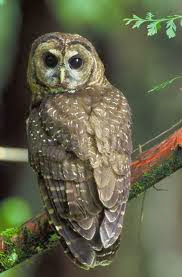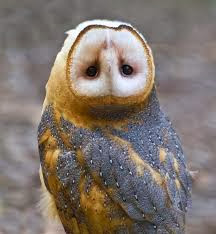Here are some unique and scientific facts about owls:
1. Owls are a group of birds that are members of the order Strigiformes, there are about 222 known species that spread throughout the world except Antarctica, most of Greenland, and some remote islands.
2. This owl belonged bird of prey (carnivores, meat eaters) and are nocturnal animals (nocturnal).
3. Owls are known for big eyes and facing forward, not like most other bird species whose eyes are turned to the side.
4. Owls have sharp hooked beak like an eagle beak and feather arrangement in the head in a circle face, the look "face" owl is so impressive and sometimes creepy.
5. Owl tail is generally short, but the wings are large and wide. Wing span reaches about three times the length of its body.
6. Most types of owls hunt at night, although partly hunt when the dim dawn and evening (crepuscular) and there are even some that hunt during the day.
7. Eyes facing forward, making it possible to measure the distance to the right; half strong and sharp; legs are nimble and able to grip it firmly, and the ability to fly without the noisy, is the basis for the ability to hunt in the dark of night.
8. Owls hunt a variety of animals such as insects, frogs, rats, and others.
9. Owls nest primarily made in the holes of trees, or in the nation's palm leaf midrib. Some types also often take advantage of the spaces in the building, such as under the eaves or holes are empty.
10. Owl eggs depends on the type, laying between one to four grains, mostly white or mottled white.
11. The owl is one of the owls that are often used as animal pest control rats in the agricultural sector.
12. In agriculture, a pair of owls can protect 25 hectares of rice. Within a year, the owl's tail can prey on rats in 1300.
13. Owls are one of the most loyal animals because only one partner for a lifetime.
14. Owls have three eyelids: one for blinking, one for sleeping, one for cleaning the eye.
15. Owl face and furry flat like a disc, it is useful to collect the sound waves made by prospective prey.
Why Owls can turn their heads 180 degrees?
The owl is turning the head 180 degrees to the back and to the down
Owl-known for its ability to rotate the head half a full rotation. Owl head can look back without turning his body.
Humans have seven bones in the neck, while the owl has 14 bones. More Bones means more flexible. That is why the owl can rotate its head half round.
1. Owls are a group of birds that are members of the order Strigiformes, there are about 222 known species that spread throughout the world except Antarctica, most of Greenland, and some remote islands.
2. This owl belonged bird of prey (carnivores, meat eaters) and are nocturnal animals (nocturnal).
3. Owls are known for big eyes and facing forward, not like most other bird species whose eyes are turned to the side.
4. Owls have sharp hooked beak like an eagle beak and feather arrangement in the head in a circle face, the look "face" owl is so impressive and sometimes creepy.
5. Owl tail is generally short, but the wings are large and wide. Wing span reaches about three times the length of its body.
6. Most types of owls hunt at night, although partly hunt when the dim dawn and evening (crepuscular) and there are even some that hunt during the day.
7. Eyes facing forward, making it possible to measure the distance to the right; half strong and sharp; legs are nimble and able to grip it firmly, and the ability to fly without the noisy, is the basis for the ability to hunt in the dark of night.
8. Owls hunt a variety of animals such as insects, frogs, rats, and others.
9. Owls nest primarily made in the holes of trees, or in the nation's palm leaf midrib. Some types also often take advantage of the spaces in the building, such as under the eaves or holes are empty.
10. Owl eggs depends on the type, laying between one to four grains, mostly white or mottled white.
11. The owl is one of the owls that are often used as animal pest control rats in the agricultural sector.
12. In agriculture, a pair of owls can protect 25 hectares of rice. Within a year, the owl's tail can prey on rats in 1300.
13. Owls are one of the most loyal animals because only one partner for a lifetime.
14. Owls have three eyelids: one for blinking, one for sleeping, one for cleaning the eye.
15. Owl face and furry flat like a disc, it is useful to collect the sound waves made by prospective prey.
Why Owls can turn their heads 180 degrees?
Owl-known for its ability to rotate the head half a full rotation. Owl head can look back without turning his body.
Humans have seven bones in the neck, while the owl has 14 bones. More Bones means more flexible. That is why the owl can rotate its head half round.

